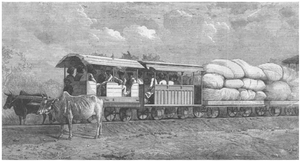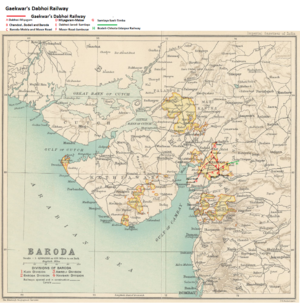Gaekwar's Dabhoi Railway
| Gaekwar's Dabhoi Railway | ||
|---|---|---|
| [[Image:|150px| ]] | ||
| Line of route | ||
| See map and text | ||
| Gauge / mileage | ||
| 2'6" NG | 92 miles(1909) | |
| 2'6" NG | 154 miles(1918) | |
| 2'6" NG | 187 miles(1919) | |
| Timeline | ||
| Key locations | ||
| Presidency | Bombay | |
| Stations | Baroda | |
| System agency | ||
| Owned by Baroda Durbar | ||
| Worked by Bombay, Baroda and Central India Railway(B&CIR) | ||
| 1921 | Renamed Gaekwar's Baroda State Railway (GBSR) | |
| How to interpret this infobox | ||
The Gaekwar's Dabhoi Railway(GDR) was the original name of the ox-driven line between Dabhoi and and Mayagam (some records give this as ‘Mayagam Karjan, a distance of 20 miles(33km) and opened in 1862. The line was laid during the reign of Sir Khanderao Gaekwar of Baroda, the Maharaja of Baroda. Owned by the Princely Baroda State, it was the first railway built and operated by a Native Prince. [1] [2]. The network expanded finally becoming the Gaekwar's Baroda State Railway(GBSR) in 1921.
Note
- Some records refer to this railway as the Dabhoi Railway
- Some web record, including Wikipedia, incorrectly name this railway as the Gaekwar's Baroda State Railway; which in fact did not come into existence until 1921.
History

The original line was a 2ft 6in/762mm narrow gauge(NG) with rails weighing 13 lbs to a yard. The line was designed and constructed by Arthur William Forde. A pair of oxen used to haul trains composed of 4-6 vehicles. In 1863, Khanderao purchased 3 steam locomotives built by Neilson and Co., Glasgow. These 0-4-0 ST locomotives proved to be too heavy for the rails. During the reign of Malharrao in 1871, the old rails were removed and new rail 30 lbs to a yard were laid [3]. The 20mile(32km) ‘Dabhoi-Miyagam’ line was reopened for traffic on 8 April 1878 [4]. This is shown in Red as “Line A” on the Route Map.
An Agreement was made, effective from 1 Jan 1897, with the Bombay, Baroda and Central India Railway(BB&CIR) for the management, maintenance and working of the ‘Dabhoi Railway’ on behalf of the ‘Government of His Highness the Maharaja Gaekwar of Baroda’ [4]. It is not known if BB&CIR were responsible prior to this date. Certainly from this date onwards the BB&CIR were totally responsible for the operation.
Dabhoi by 1909 had become an important narrow gauge(NG) railway junction as the ‘Gaewar’s Dabhoi Railway’ was expanded; it became the centre where the lines from Miyagam, Chandod , Bodeli and Baroda converge [5]. These are marked “Lines B” on the map.
A Contract dated 8 April 1907, effective from 1 Jan 1906, between the Secretary of State and the BB&CIR formalised the arrangements for ‘the management, maintenance and working’ of the Dabhoi railway [4].
Further expansion of the network initiated an Agreement, dated 9 May 1916 between the ‘Government of His Highness the Maharaja Gaekwar of Baroda’ and the BB&CIR for the ‘management, maintenance and working, by the Company, of the Miyagam-Malsar (“Line D”), Dabhoi-Jarod-Samlaya (“Line E”), , Masor Road-Jambusar ("Line F”), Samlaya-Savli-Timba (“Line G”) ... from the dates they are or shall have been opened for public traffic’ [4].
With the completion of the ‘Dabhoi-Jarod’ Line’ in 1919 a total of 187 miles(299km) of ‘Gaekwars Dabhoi Railway’ was open [4].
The GDR became the narrow gauge(NG) part of the Gaekwar's Baroda State Railway (GBSR) on Oct 1st 1921 as result of the continued expansion or the network into Baroda State. At this time the NG system was 268 miles(429km) in length [6].


Opening of ‘Gaekwar’s Dabhoi Railway’ lines in chronological order
Information retrieved from “Administration Report on Railways 1918” [4]
Note: Town Names – modern names in (brackets) as seen on Google Maps Baroda (Vadodora); Miyagam (Miyaram), Chhota Udaipur (Chhota Udepur)
- ‘Dabhoi–Miyagam Line’ (“Red Line A”); 20 miles(32km) NG: 1862, the original Gaekwar's Dabhoi Railway, driven by oxen; 1873 Apr 4, line re-laid in stronger rails; 1878 Jan 8, date of reopening, locomotives introduced from about 1878.
- ‘Dabhoi-Chandod Line’ (“Red Line B”); 11 miles(17km) NG: Dabhoi to Chandod, 11 miles(17km), 1879 Apr 15.
- ‘Dabhoi-Bodeli Line’ (“Line B”); 22 miles(35km) NG: Dabhoi to Sankheda Bahadarpur, 10 miles(15km), 1879 Sep 17; Sankheda Bahadarpur via Chhuchapura Junction to Bodeli, 12 miles(20km), 1890 Jun 16.
- ‘Dabhoi-Baroda Line’ (“Red Line B”); 19miles(34km) NG: Dabhoi to Goya Gate, 17 miles(31km), 1880 Jul 1; Goya Gate to Baroda (Vishvamitri Station), 2 miles(3km), 1881 Jan 24.
- ‘Baroda-Masor Road Line’ (“Red Line C”); 20 miles(32km) NG: Baroda (Vishvamitri Station) to Padra, 7 miles(11km), 1897 Jul 1; Padra to Mobha, 6 miles(10km), 1903 Jul 10; Mobha to Masor Road, 7 miles(11km), 1904 Nov 1.
- ‘Miyagam Karjan-Malsar Line’ (“Red Line D”); 24 miles(44km) NG: extension to the ‘Dabhoi-Miyaram Line’, first proposed in 1906 as the ‘GDR ‘ Miyagam-Sinor Branch’[7], and later extended giving total 44 miles(56km) from Miyagam via Choranda Junction and Sinor to Malsar, 1912 Jan 15
- ‘Dabhoi-Timba Line’ (“Red Line E”) 62 miles(100km) NG: Daboi to Jarod, 24 miles(38km), 1913 Nov 15; Jarod to Samlaya Junction, 5 miles(9km), 1915 Dec 13; Samlaya via Savli to Timba, 33 miles(53km) 1919 Feb 1
- ‘Masor Road-Jambusar Line’ (“Red Line F”); 7 miles(11km) NG: an extension of the ‘Baroda-Masor Road Line’ reaching Jambusar, 1917 May 1.
Lines Worked as an extension to Gaekwar’s Dabhoi Railway(GDR)
- ‘Bodeli-Chhota Udaipur Railway’ (“Green Line H”) 22.5 miles(36km) NG was sanctioned in 1915 and constructed by the BB&CIR on behalf of the; Baroda and Chota Udaipur Durbars. Opened in 1917 Dec 1, connected to the GDR ‘Daboi-Bodeli Line’ at Chhuchapura Junction and worked by BB&CIR [8]. The progress had been restricted by “the large contribution arising from lack of funds caused by the large contribution, both direct and indirect, which the Native States had made to the Imperial resources for the conduct of the war” [7].
Proposals and Surveys on behalf of the GDR
A number of projects were considered, some were abandoned and, several were postponed on account of WW1. The progress had been restricted by “the large contribution arising from lack of funds caused by the large contribution, both direct and indirect, which the Native States had made to the Imperial resources for the conduct of the war” [7]. Some were finally completed after 1921 by GBSR.
- ‘Broach-Jambusar-Masor Road(Kangat) Branch’, 31 miles (50km) NG: proposed 1903 [7] The GDR ‘Masor Road-Jambusar Section’ was finally opened in 1917. The ‘Broach-Jambusar Railway’ was constructed by the BB&CIR and opened in Nov 1914. 1914 as a branch of the Bombay, Baroda and Central India Railway(BB&CIR) [9]
- 'Kosamba-Zankavao Section’, 26 miles(42km) NG, surveyed in 1900 [7]. Not constructed until after 1921 by the GBSR as part of the ‘Kosamba- Zankavao-Umarpada Line’.
- ‘Zankavao-Vajipur Section’, 26 miles(42km) NG, surveyed in 1903 [7], apparently never constructed.
- ‘Nar-Nadiad Loop’ 20 miles(32km) NG, surveyed in 1905 [7]. Finally constructed as part of the ’Nar-Petlad-Nadiad Line’ via Sojitra, Dewa(Deva), opened after 1921 by GBSR.
- ‘Bahadarpur -Garda-Songhir Extension’, c 8 miles(13km) NG, proposed before 1906 from Bahadarpur (on the ‘Daboi-Bodeli Line’ ) due south to Garda on the Heran River [7]. Apparently not constructed.
- ‘Miyagram-Sinor Branch’, c.20 miles(32km) NG, proposed 1906 [7]. Opened in 1915 as part of the GDR ’Miyaram Karjan-Malsar Extension’.
- ‘Barodi-Savli Line’, 32 miles(51km) NG, proposed 1906 [7]. The section Samlaya via Savli to Timba was opened in 1919. Baroda to Samlaya was completed after the GBSR took over in 1921.
- ‘Choranda-Moti Koral Line’, 12 miles(19km) NG, sanctioned in 1914 for the GDR [4]. Finally completed and opened by GBSR in 1921 [10].
- ‘Motipura -Taukhala Line’, 26 miles(42km) NG, sanctioned in 1914 for the GDR [4]. Finally completed and opened by GBSR in 1923 March 15 [10].
Further Information
For further development after 1921 see Gaekwar's Baroda State Railway.
References
- ↑ "Gaekwar's Baroda State Railway" by Vikas Singh, Editor of Indian Steam Railway Society Magazine; Retrieved 24 Oct 2016
- ↑ “History of Vadodara-Baroda / Baroda State Railways” ; Retrieved 24 Oct 2016
- ↑ Wikipedia “Baroda State Railway”; Retrieved 12 Oct 2016
- ↑ 4.0 4.1 4.2 4.3 4.4 4.5 4.6 4.7 " Administration Report on the Railways in India – corrected up to 31st March 1918"; Superintendent of Government Printing, Calcutta; page 36 and 37; Retrieved 12 Oct 2016
- ↑ “Imperial Gazetteer of India 1908”, v. 11, p. 100 ; Retrieved 24 Oct 2015
- ↑ “History of Vadodara – Railway Museum /GBSR” ; Retrieved 12 Oct 2015
- ↑ 7.00 7.01 7.02 7.03 7.04 7.05 7.06 7.07 7.08 7.09 Histories of (Indian)Railway Projects ...up to June 1906 “Railways in India – GOI Administrative Report 1916-17 / Native States Lines” page 17 and 18; Retrieved 24 Oct 2016
- ↑ " Administration Report on the Railways in India – corrected up to 31st March 1918"; Superintendent of Government Printing, Calcutta; page 35; Retrieved 24 Oct 2016
- ↑ “Administration Report on Railways 1918” page35 (pdf44) ; Retrieved 13 Feb 2018
- ↑ 10.0 10.1 ”Indian railways new chronology” by Keith Scholey